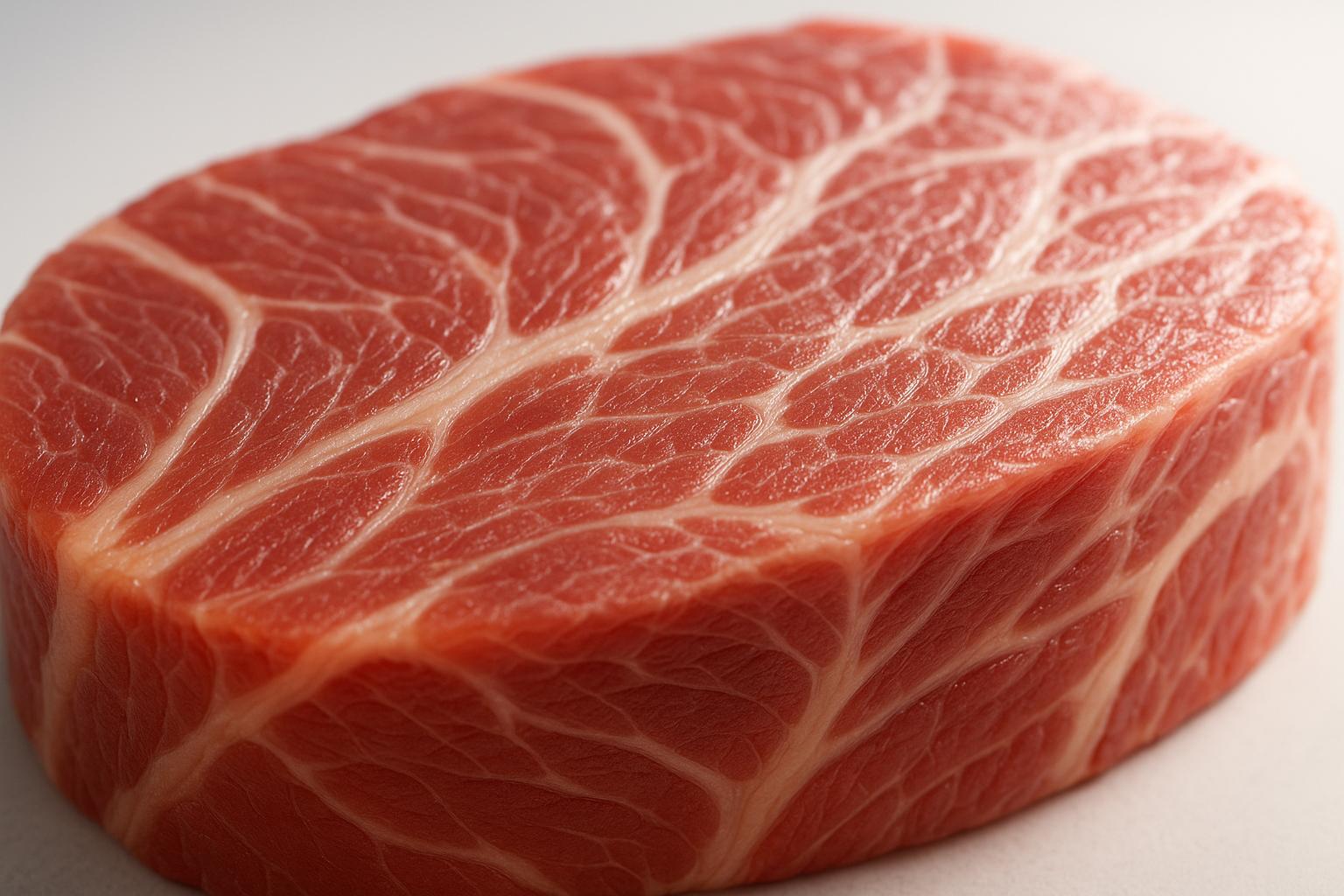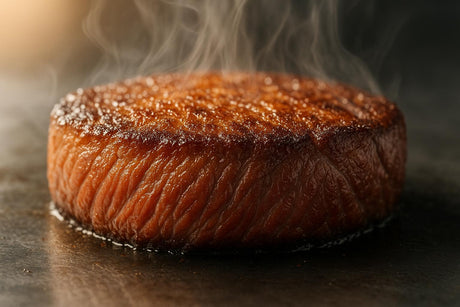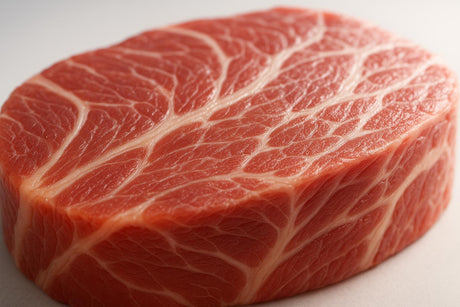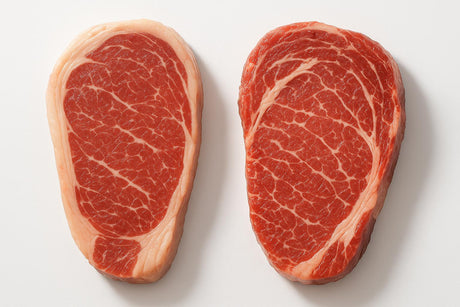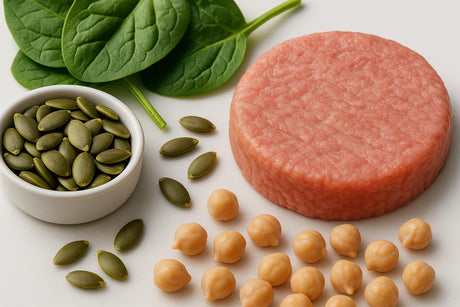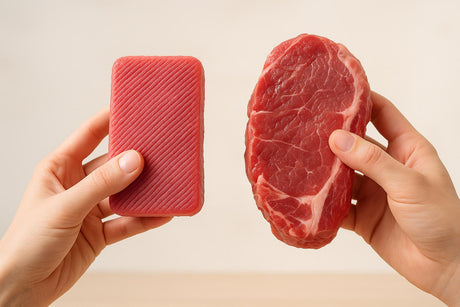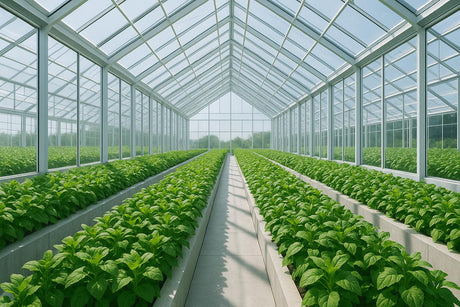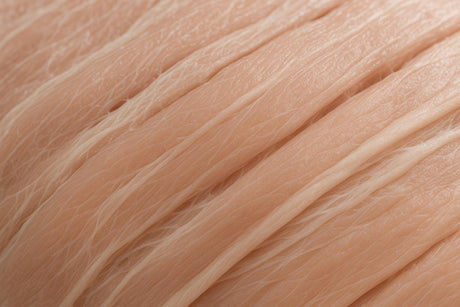Does cultivated meat taste like regular meat? Early taste tests suggest it’s close, but not identical. Cultivated chicken has been praised for its flavour, with testers giving it an average score of 8/10 for replacing conventional chicken. Salmon is milder, softer, and lacks the "fishy" aroma some expect. Foie gras, made with quail cells, has been particularly well-received for its creamy texture and versatility in dishes.
Key points:
- Taste: Clean and mild, though less complex than regular meat.
- Texture: Softer and less fibrous but improving with methods like scaffolding and bioprinting.
- Cooking: Retains moisture well and cooks evenly, making it consistent.
Challenges include replicating the bold flavours and aromas of conventional meat, improving texture, and addressing occasional saltiness. Early feedback has been positive, but broader testing is needed to confirm consumer acceptance. For updates on tastings and product launches in the UK, platforms like Cultivated Meat Shop are worth exploring.
What Does Lab-Grown Meat Taste Like? We Test It Out
Early Taste Tests: What People Are Saying
Initial tastings suggest that cultivated meat is edging closer to the flavour of traditional meat, though there are still areas that need refining.
Taste Profiles of Cultivated Chicken, Salmon, and Foie Gras
Cultivated chicken has left a strong impression on many testers, with its flavour described as strikingly close to the real thing. In one trial, participants rated their likelihood of swapping regular chicken for the cultivated variety at an average of 8 out of 10[4]. While the taste was highly praised, some noted slight differences in texture compared to conventional chicken.
Cultivated salmon, on the other hand, has been noted for its milder taste. Testers described it as softer than traditional lox, with the absence of the distinctive fishy smell[2]. Despite these subtle variations, some found the texture to be spot-on.
Cultivated foie gras, branded as "Forged Gras" by Australian company Vow, has received particularly glowing feedback. Made with 51% cultivated quail cells, the product features a light, whipped-cream-like texture[2]. Chefs have showcased its versatility by using it in dishes ranging from croquettes to grilled bagels topped with duck butter. In Singapore, a bagel featuring cultivated foie gras is priced at around £15, while full tasting menus incorporating it range from £90 to £150 per person[2].
These tasting notes highlight both the promise and the hurdles that cultivated meat faces as it seeks to replicate the experience of traditional meat.
Good Feedback and Areas for Improvement
Testers have praised cultivated meat for its appealing flavour and its close resemblance to conventional meat[2][3]. Even vegetarians and vegans, who often participated in the trials, were surprised by how convincingly it mimicked traditional meat compared to plant-based alternatives.
Cultivated foie gras has stood out for its rich, creamy texture and its ability to adapt to various cooking styles. However, there are still hurdles to overcome. Textural issues remain a key challenge, with some products described as rubbery or softer than expected. Additionally, the seasoning has occasionally been criticised for being overly salty[2][3]. Another common suggestion was to increase the proportion of cultivated meat in hybrid products to enhance their appeal.
Limits of Current Taste Studies
While the early feedback is encouraging, the scope of these studies is limited, which could affect the reliability of these initial impressions. Many taste tests have involved small groups - one trial included just 13 participants[4]. Even larger events, such as the Florida tasting, only represent a small segment of potential consumers. Moreover, the diversity of participants has been limited, with most tastings targeting specific groups rather than a broad demographic. Meat-eaters often focus on authenticity, while vegans and vegetarians sometimes find the realistic taste both impressive and slightly unsettling[3].
Another issue raised by participants is the need for greater transparency. Some have called for clearer details about the ingredients and production processes involved[3]. Additionally, the novelty factor of cultivated meat may influence early reactions, with curiosity and excitement potentially skewing perceptions.
To gain a clearer picture of how cultivated meat will be received on a larger scale, broader and more diverse testing will be essential. Only then can we determine whether these early positive reactions translate into lasting consumer acceptance.
How Cultivated Meat Compares to Regular Meat
After early reviews hinted at promising taste profiles for specific cultivated meat products, more detailed comparisons with traditional meat are now emerging. So, how does cultivated meat stack up against its conventional counterpart?
Building on those initial impressions, sensory tests have provided a clearer picture. Cultivated meat generally offers a mild, clean flavour. However, it lacks the boldness and complexity of conventional meat - less gamey, with fewer rich, robust flavour compounds. Its texture is softer but still comparable to traditional options, according to early evaluations [2][3].
When it comes to texture, cultivated products often deliver a similar mouthfeel to conventional meat, though earlier prototypes were noted to be slightly softer and less fibrous [2][4]. For example, cultivated chicken tends to feel less firm compared to traditional poultry, while cultivated salmon has been praised for its texture, even though it occasionally lacks the distinctive fishy aroma that some consumers expect [2].
Cooking performance is another area where cultivated meat shows potential. It cooks evenly and retains moisture well, making it more forgiving for home cooks. Unlike conventional meat, where cooking results can vary depending on the cut or fat content, cultivated meat offers more consistent outcomes - something that could appeal to both home chefs and professional kitchens [2].
| Aspect | Cultivated Meat | Conventional Meat |
|---|---|---|
| Taste | Mild, clean, less gamey | Varied, richer flavour |
| Texture | Softer, but comparable | Firm, fibrous |
| Cooking Behaviour | Even cooking, retains moisture | Varies by cut |
Despite these strengths, there’s room for improvement. Sensory evaluations have highlighted areas where cultivated meat could evolve. In one public tasting, 73% of participants sampling a hybrid cultivated chicken product with soy-based components suggested further refinements. Common feedback focused on enhancing flavour complexity and achieving a firmer, more realistic texture.
One challenge lies in replicating key aroma compounds, such as furans and pyrazines, which contribute to the distinctive flavours of conventional meat. Current production methods are still working to fully recreate these elements, leading to subtle but noticeable differences [4].
For those curious about the progress of cultivated meat, opportunities to explore the latest products are growing. Companies like Cultivated Meat Shop now offer waitlist sign-ups and detailed previews of upcoming taste tests, keeping consumers informed about new developments and launches.
sbb-itb-c323ed3
What Affects Taste and Texture
The flavour and texture of cultivated meat depend on several factors, which explains why some products closely resemble traditional meat while others still need improvement. Techniques like scaffolding and bioprinting help replicate the alignment of muscle fibres, which directly impacts texture. Meanwhile, cultivated fat and other ingredients are critical in developing the flavour.
Production Methods and Their Impact
The way cultivated meat is produced significantly influences its texture and mouthfeel. Scaffolding techniques provide a framework for cells to grow, allowing muscle fibres to align in a way that mimics natural development. This alignment is key to achieving the fibrous texture people associate with meat.
Take cultivated foie gras as an example. When scaffolding techniques are used, it results in a creamy texture akin to traditional foie gras, making it suitable for grilling or turning into croquettes [2]. On the other hand, cultivated salmon grown without extensive scaffolding has been described as slightly softer than conventional lox, though many tasters still found its texture appealing [2].
Bioprinting takes things further by creating layered textures that resemble conventional cuts of meat. This method enhances both the juiciness and the overall mouthfeel, setting the stage for the ingredients to shine in flavour development.
Ingredients and Flavour Development
The mix of cultivated animal cells and additional ingredients is a major factor in determining the taste of cultivated meat. Cultivated fat plays a key role here, as it carries flavour compounds that contribute to the characteristic taste of different meats. It also adds to the juiciness and tenderness [1].
Many early products are hybrids, blending cultivated cells with plant-based proteins or binders. Getting the right balance in these formulations is crucial for achieving a taste and texture that consumers will enjoy.
Cultivated fat also contributes during cooking, particularly through the Maillard reaction. This browning process creates savoury crusts and complex aromas, bringing cultivated meat closer to the flavour profile of traditional meat.
Challenges in Copying Regular Meat
Reproducing the full sensory experience of conventional meat remains a complex challenge. One major hurdle is replicating the intricate volatile compounds - like furans, pyrazines, oxazoles, and sulfur-containing molecules - that give traditional meat its unique aroma and flavour [4]. As a result, some cultivated meat products have a milder or less distinct flavour compared to their conventional counterparts.
Another challenge lies in replicating the role of fats and connective tissues, which are essential for juiciness and for releasing flavour during cooking. While some products use plant-based fats or engineered animal fat cells as substitutes, achieving the same seamless integration and distribution as in traditional meat is still a technical obstacle [4][6].
In some cases, cultivated meat has been described as slightly rubbery, highlighting the need for further refinement. These challenges illustrate the ongoing work in perfecting cultivated meat, with innovations continuing to push the boundaries of what’s possible.
What's Next: The Future of Cultivated Meat
The cultivated meat industry is moving quickly from experimental stages to products ready for the market. With regulatory approvals already underway in key regions, there’s growing anticipation that the UK and Europe could follow suit. Early taste tests are just the start of what consumers might soon see on their plates.
Product Launches and Tasting Events
As taste profiles improve, the focus is shifting towards public tastings and product rollouts. Singapore has taken the lead, offering cultivated foie gras and salmon in public tastings, while the US has hosted events featuring cultivated chicken. These launches highlight not only advancements in the field but also the growing curiosity among consumers.
In Singapore, Vow’s cultivated foie gras has already made its way to high-end restaurants and even takeaway options. A foie gras bagel, priced at around £15, and set dinner menus ranging from £90 to £150 have given diners a chance to sample the product. Feedback has been generally positive, with diners describing it as "genuinely delicious" and appreciating its texture, though some noted it was a bit saltier than expected[2].
Events like Upside Foods’ public tasting in the US have further demonstrated the increasing interest in cultivated meat, offering valuable feedback to fine-tune these products before they hit the broader market.
In the UK, however, regulatory approval under the Food Standards Agency’s novel foods framework is still pending. Experts believe that public tastings and limited product launches could happen within the next year or two, as more companies submit their safety dossiers[5]. These developments underline the importance of accessible, reliable information for consumers as the industry inches closer to mainstream availability.
Cultivated Meat Shop: A Go-To Resource

With cultivated meat edging closer to UK shelves, Cultivated Meat Shop has positioned itself as a vital resource for curious consumers. The platform provides UK-specific information, including previews of upcoming products and a regularly updated "Insights & News" section. Recent articles cover topics like "Cultivated Meat in Asia: Overcoming Market Barriers" and "5 Ways Cultivated Fat Improves Meat Flavour"[1].
For those eager to stay informed or participate in future tastings, registering interest through Cultivated Meat Shop ensures direct access to the latest updates and events.
Conclusion: What to Expect from Cultivated Meat's Taste
Early taste tests suggest that cultivated meat holds strong promise for making its way onto UK plates. Feedback from tasters highlights that cultivated meat delivers on its primary goal - offering a taste and texture that closely resembles traditional meat. Trials with products like cultivated foie gras and chicken have received positive reactions, showing they have the potential to satisfy even the most discerning meat enthusiasts[2][3].
Interestingly, cultivated meat seems to outperform plant-based alternatives in taste comparisons. For example, 67% of sensory panelists favoured cultivated chicken, and even vegan and vegetarian participants noted its convincing meat-like qualities. This suggests that cultivated meat could appeal to a wide range of dietary preferences, making it an option for more than just meat eaters[4].
Some areas, like refining texture, adjusting saltiness, and enhancing flavour depth, still need improvement. However, these are natural hurdles for any emerging food technology. As production techniques evolve and the proportion of cultivated cells in these products increases, these issues are expected to diminish significantly.
For UK consumers eager to stay informed, Cultivated Meat Shop offers a valuable resource. With its detailed guides, updates in the "Insights & News" section, and pre-market waitlist opportunities, it’s an excellent way to keep track of new developments. Although cultivated meat isn’t commercially available yet, platforms like this ensure you’re well-prepared to make informed choices when it does arrive.
As production processes advance, these early taste tests hint at a future where cultivated meat consistently delivers on taste and texture, with ongoing refinements making it an even more appealing option for consumers.
FAQs
How does the texture of cultivated meat compare to traditional meat, and what methods are used to enhance it?
The texture of cultivated meat aims to mirror that of traditional meat, as it’s created using the same animal cells. Early taste testers have noted that products like chicken and beef come impressively close to matching the texture of their conventional counterparts. That said, some cuts and preparations are still being fine-tuned to perfect their mouthfeel.
To achieve this, producers are employing techniques like scaffolding. This method involves creating a structure for the cells to grow on, imitating the muscle fibres found in natural meat. It plays a key role in delivering the chewiness and juiciness that people expect. With ongoing advancements in the field, the texture of cultivated meat is likely to become virtually indistinguishable from the real thing.
What makes replicating the flavour and aroma of traditional meat in cultivated meat so challenging?
Replicating the rich taste and aroma of traditional meat in cultivated meat is no small feat. The flavour of conventional meat comes from a delicate interplay of factors like fat content, muscle structure, and how these elements react during cooking. To recreate this in cultivated meat, scientists must use precise methods to grow and combine cells in a way that mirrors these natural characteristics.
Aroma is just as essential to the overall experience. The distinctive smell of cooked meat largely stems from chemical reactions, such as the Maillard reaction, which occurs when proteins and sugars interact under heat. Researchers are actively working on replicating these reactions in cultivated meat to ensure it delivers the same savoury and satisfying sensory experience that consumers associate with traditional meat.
What affects the taste and texture of cultivated meat, and how do production techniques like scaffolding and bioprinting contribute?
The flavour and texture of cultivated meat depend on various factors, such as the type of animal cells selected, the nutrients used during growth, and the production techniques applied. These components work in harmony to recreate the taste and feel of traditional meat.
Key techniques like scaffolding and bioprinting are essential in shaping the end product. Scaffolding provides a framework for cells to grow, imitating the natural structure of meat, while bioprinting enables precise layering of cells to create specific textures. Together, these methods help cultivated meat closely mirror the appearance, texture, and flavour of conventional meat, delivering a familiar and enjoyable experience for consumers.

